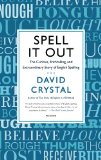Summary | Excerpt | Reviews | Beyond the Book | Readalikes | Genres & Themes | Author Bio

Critics' Opinion:
Readers' Opinion:
First Published:
Jun 2013, 336 pages
Paperback:
Dec 2014, 336 pages
 Book Reviewed by:
Book Reviewed by:
Jo Perry
Buy This Book
M,m
M has come from a Semitic letter via the Greek, Etruscan and Latin alphabets (where it sometimes had four vertical strokes) into Old English. The lower-case letter appeared in a rounded form in handwriting.
N,n
N achieved its present-day shape in the Latin alphabet after a history of various angular forms. The rounded lower-case letter resulted from scribal handwriting practice. It appears in Old English, and has been used with very little change in form since.
O,o
O represented a consonant in the Semitic alphabet, and was used by the Greeks for both a short and a long vowel, these later being distinguished as two symbols, omicron ('little o', for the short sound) and omega ('big o', for the long sound). The Romans adopted omicron, giving it both short and long values, and these values were also assigned to the letter when it was used in Old English. The lower-case letter is a smaller form of the capital.
P,p
P was a Semitic letter which came into Greek, Etruscan and Latin in a variety of forms. It eventually standardised with a rounded upper element. The lower-case letter is a smaller version of the capital, with the additional distinction that the vertical stroke falls below the line of writing.
Q,q
The location of the distinctive stroke has varied greatly from the Semitic alphabet through Greek and Etruscan to Latin, until a curved 'tail' at the bottom and to the right of the O became the standard form. The letter was dropped in Classical Greek, but retained in Etruscan as the representation of /k/ before a u vowel, and this practice was taken over in Latin. The lowercase letter developed in scribal writing as a smaller version of the capital, with the tail lengthened below the line and moved to the right, to facilitate rapid script.
R,r
R appeared in the Semitic alphabet in a variety of forms, and was taken into Greek with a single descending stroke. A version with an additional short 'tail' became the basis of the Latin form, with the tail lengthened to avoid confusion with P. The lower-case form arose as a simplified character in handwriting, with the curve and tail smoothed into a single wavy horizontal stroke.
S,s
The Semitic and Greek alphabets had a variety of symbols for s-like (sibilant) sounds, one of which – a rounded form – was taken over by the Etruscans and Romans and eventually entered Old English, usually written in an elongated way. The lower-case letter is simply a smaller version of the capital, though a form resembling an f (but without the cross-bar) came to be used in handwriting in the 17th century, and is found in print until the early 19th century.
T,t
T was used in the Semitic alphabet, came into Latin via Greek and Etruscan, and entered Old English. The handwritten form was a smaller and rounded version of the capital, with a right-curved base. The vertical stroke later became lengthened above the horizontal, forming a cross-bar, in order to distinguish the handwritten t from c.
U,u
The ancestor of U is to be found in the Semitic alphabet, eventually emerging in Latin as a V used for both consonant and vowel. The lower-case letter developed as a smaller and rounded form in handwriting. In Middle English, both v and u appear variously as consonant and vowel, v often being found at the beginning of a word and u in the middle. This eventually led to v being reserved for the consonant and u for the vowel, though it was not until the late 17th century that this distinction became standard.
V,v
The history of this letter is the same as for U. Once a systematic distinction had emerged between the two letters, a larger version of u became standard as a capital, and a small version of V became standard as a lower-case form.
W,w
From Spell it Out by David Crystal. Copyright © 2013 by the author and reprinted by permission of St. Martin's Press, LLC.





The Flower Sisters
by Michelle Collins Anderson
From the new Fannie Flagg of the Ozarks, a richly-woven story of family, forgiveness, and reinvention.

The House on Biscayne Bay
by Chanel Cleeton
As death stalks a gothic mansion in Miami, the lives of two women intertwine as the past and present collide.

The Funeral Cryer by Wenyan Lu
Debut novelist Wenyan Lu brings us this witty yet profound story about one woman's midlife reawakening in contemporary rural China.
Your guide toexceptional books
BookBrowse seeks out and recommends the best in contemporary fiction and nonfiction—books that not only engage and entertain but also deepen our understanding of ourselves and the world around us.